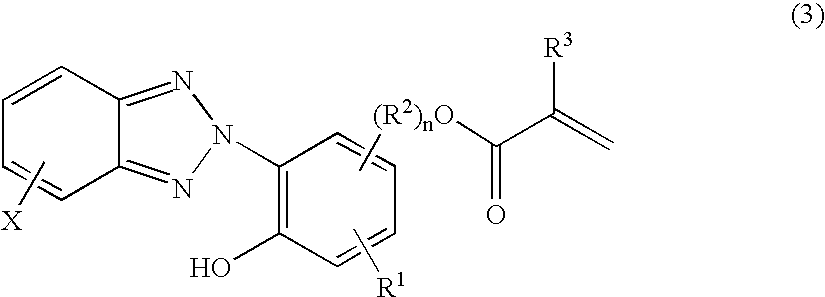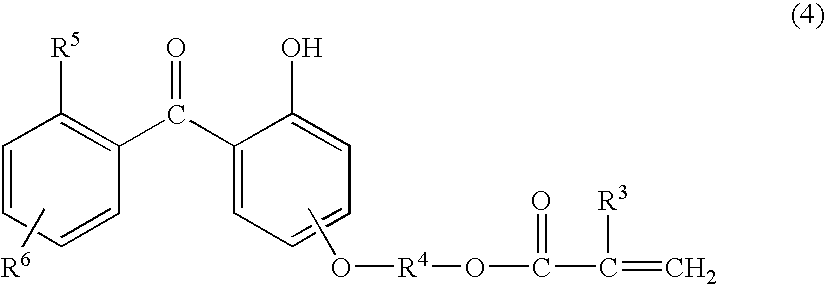Primer composition and coated article
a technology of primer composition and coated article, which is applied in the direction of coating, transporting and packaging, layered products, etc., can solve the problems of adversely affecting the surface properties of polycarbonate resin, and affecting the adhesion of the primer layer to the substrate or the overlying protective coating of colloidal silica, etc., to achieve improved light resistance, improved weather resistance coefficient coefficient ratio
- Summary
- Abstract
- Description
- Claims
- Application Information
AI Technical Summary
Benefits of technology
Problems solved by technology
Method used
Image
Examples
synthesis example 1
[0138]A 2-liter flask equipped with a stirrer, condenser and thermometer was charged with 152 g of diacetone alcohol as the solvent and heated at 80° C. in a nitrogen stream. To the flask were sequentially admitted a 240 g portion of a monomer mixture which had been previously prepared from 67.5 g of 2-[2′-hydroxy-5′-(2-methacryloxyethyl)phenyl]-2H-benzotriazole (RUVA-93 by Otsuka Chemical Co., Ltd.), 90 g of γ-methacryloxypropyltrimethoxysilane, 270 g of methyl methacrylate, 22.5 g of glycidyl methacrylate, and 350 g of diacetone alcohol, and a 54 g portion of a solution which had been previously prepared by dissolving 2.3 g of 2,2′-azobis(2-methylbutyronitrile) as the polymerization initiator in 177.7 g of diacetone alcohol. Reaction was effected at 80° C. for 30 minutes, after which the remainder of the monomer mixture and the remainder of the polymerization initiator solution were simultaneously added dropwise at 80-90° C. over 1.5 hours. The reaction solution was stirred at 80-...
synthesis example 4
[0141]A 2-liter flask equipped with a stirrer, condenser and thermometer was charged with 338 g of methyltrimethoxysilane and with stirring, maintained at 20° C. To the flask, 98 g of water-dispersed colloidal silica (Snowtex 0 with an average particle size of 15-20 nm, Nissan Chemical Industries Ltd., SiO2 content 20%) and 230 g of a 0.25N aqueous acetic acid solution were added, and the contents were stirred for 3 hours. Stirring was continued at 60° C. for a further 3 hours, after which 300 g of cyclohexanone was added, and byproduct methanol was distilled off under atmospheric pressure. Then 300 g of isopropanol and 134 g of an isopropanol solution of 0.25% tetrabutylammonium hydroxide were added. The solution was further adjusted with isopropanol to a nonvolatile content of 20% as measured according to JIS K-6833. The organopolysiloxane solution thus obtained had a viscosity of 4.1 mm2 / s and a Mw of 2,500 as measured by GPC. This is designated organopolysiloxane B-1.
synthesis example 5
[0142]A 2-liter flask equipped with a stirrer, condenser and thermometer was charged with 302 g of methyltrimethoxysilane and 97 g of γ-glycidoxypropylmethyldiethoxysilane, and with stirring, maintained at 20° C. To the flask, 308 g of a 0.25N aqueous acetic acid solution was added, and the contents were stirred for 3 hours. Stirring was continued at 60° C. for a further 3 hours, after which 300 g of cyclohexanone was added, and byproduct methanol was distilled off under atmospheric pressure. Then 300 g of isopropanol and 45 g of an isopropanol solution of 0.25% tetrabutylammonium hydroxide were added. The solution was further adjusted with isopropanol to a nonvolatile content of 20% as measured according to JIS K-6833. The organopolysiloxane solution thus obtained had a viscosity of 4.5 mm2 / s and a Mw of 2,350 as measured by GPC. This is designated organopolysiloxane B-2.
[Synthesis of (E) Organosilicon Compound Having a Nitrogen Atom and an Alkoxysilyl Group in the Molecule]
PUM
| Property | Measurement | Unit |
|---|---|---|
| transparent | aaaaa | aaaaa |
| transparency | aaaaa | aaaaa |
| impact resistance | aaaaa | aaaaa |
Abstract
Description
Claims
Application Information
 Login to View More
Login to View More - R&D
- Intellectual Property
- Life Sciences
- Materials
- Tech Scout
- Unparalleled Data Quality
- Higher Quality Content
- 60% Fewer Hallucinations
Browse by: Latest US Patents, China's latest patents, Technical Efficacy Thesaurus, Application Domain, Technology Topic, Popular Technical Reports.
© 2025 PatSnap. All rights reserved.Legal|Privacy policy|Modern Slavery Act Transparency Statement|Sitemap|About US| Contact US: help@patsnap.com


